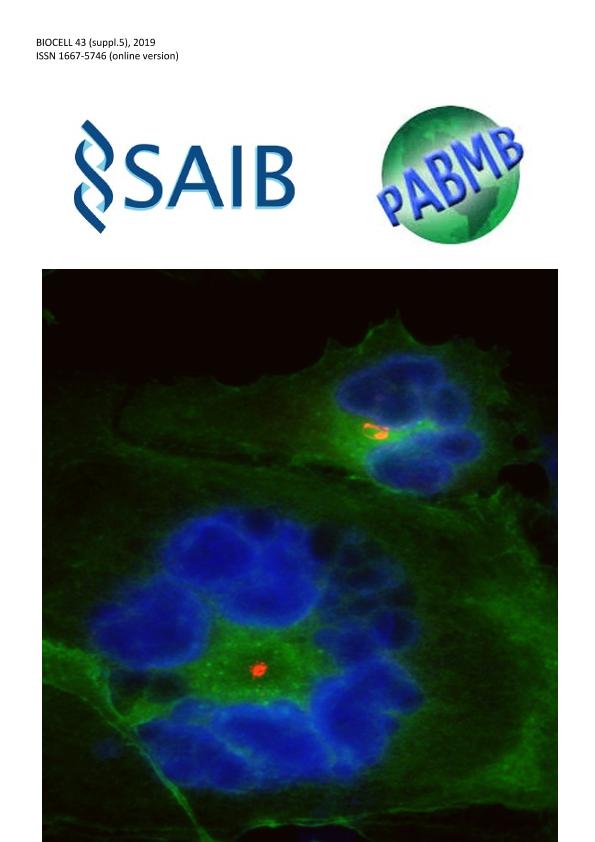Mostrar el registro sencillo del ítem
dc.contributor.author
Ocante, Teresa Ana Lia

dc.contributor.author
Bigliardo, Ana Lucia

dc.contributor.author
Sineli, Pedro Eugenio

dc.contributor.author
Sáez, Juliana María

dc.contributor.author
Benimeli, Claudia Susana

dc.date.available
2022-11-14T15:59:57Z
dc.date.issued
2019
dc.identifier.citation
Bioaugmentation of a biomixture with actinobacteria for atrazine removal; The LV Annual SAIB Meeting and XIV PABMB Congress; Salta; Argentina; 2019; 1-9
dc.identifier.issn
1667-5746
dc.identifier.uri
http://hdl.handle.net/11336/177690
dc.description.abstract
Biopurification systems (BPS) are simple and economical constructions designed to retain and degrade pesticides, in order to reduce or avoid point-source contamination. An organic biomixture (BM) constitutes the most abundant and important component of a BPS. The bioaugmentation of the BM with pesticide-degrading microorganisms is a very interesting approach to optimize its efficiency. Atrazine (ATZ) is a selective herbicide commonly applied to control the appearance of weeds in crops, mainly corn, sorghum, and sugarcane. The aim of this study were to select actinobacteria capable of removing ATZ and to evaluate the effect of the bioaugmentation of a BM with the selected actinobacteria on ATZ dissipation.A qualitative determination of tolerance to ATZ was performed by streaking 14 actinobacteria strains on Petri dishes containing starch casein agar medium with a central channel containing the ATZ solution (1000 mg L-1 and 50000 mg L-1). The tolerant strains were used to perform a quantitative determination of their ability to grow in the presence of ATZ (50 mg L-1) and to remove it from liquid minimal medium (MM). Controls were carried out in MM supplemented with glucose (1 g L-1). Microbial growth (dry weight) and residual concentration of ATZ (gas chromatography, GC) were determined after 96 h. The actinobacterium which presented the highest removal of ATZ and did not show growth inhibition in the presence of ATZ was used to inoculate a BM composed of soil, straw, and agricultural sugarcane crop residue (25:25:50). Periodic samples were collected to determine residual ATZ, total heterotrophic microorganisms (CFU g-1 BM), fluorescein diacetate hydrolysis (FDA) and acid phosphatase (AP) activities.All actinobacteria were highly tolerant to 1000 mg L-1 of ATZ and moderately tolerant to 50000 mg L-1 of ATZ. All of them were able to grow in MM supplemented with ATZ, however most of them reached statistically lower biomass than the obtained with glucose as carbon source, with the exception of Streptomyces sp. A2, A11, and M7. These strains were able to use ATZ as carbon source and to remove it from MM, presenting removal values ranging between 10% and 75%. Based on the microbial growth and ATZ removal, Streptomyces sp. M7 was selected to bioaugment the BM. The inoculation of the BM with Streptomyces sp. M7 improved significantly the ATZ removal (58%) respect to the non-biougmented BM (38%) after 28 days of incubation. The total heterotrophic population in the bioaugmented and contaminated BM (4.55 x 107 CFU g-1) did not present statistical variation respect to non-inoculated control, nor non-contaminated control. Enzymatic activities obtained in these systems ranged between 44.9 ± 0.03 and 87.2 ± 20.3 g fluorescein g-1 h-1 for FDA, and 91.82 ± 5.7 and 159.0 ± 9.0 µg p-nitrophenol g-1 h-1 for AP. These results suggest that the bioaugmentation of BM with Streptomyces sp. M7 represents a promising tool to reduce ATZ concentration in BPS.
dc.format
application/pdf
dc.language.iso
eng
dc.publisher
Tech Science Press

dc.rights
info:eu-repo/semantics/openAccess
dc.rights.uri
https://creativecommons.org/licenses/by-nc-sa/2.5/ar/
dc.subject
BIOAUGMENTATION
dc.subject
BIOMIXTURE
dc.subject
ATRAZINE
dc.subject
ACTINOBACTERIA
dc.subject.classification
Biotecnología Medioambiental

dc.subject.classification
Biotecnología del Medio Ambiente

dc.subject.classification
INGENIERÍAS Y TECNOLOGÍAS

dc.title
Bioaugmentation of a biomixture with actinobacteria for atrazine removal
dc.type
info:eu-repo/semantics/publishedVersion
dc.type
info:eu-repo/semantics/conferenceObject
dc.type
info:ar-repo/semantics/documento de conferencia
dc.date.updated
2022-11-04T12:42:51Z
dc.journal.pagination
1-9
dc.journal.pais
Argentina

dc.journal.ciudad
Salta
dc.description.fil
Fil: Ocante, Teresa Ana Lia. Universidad Nacional de Tucumán. Facultad de Bioquímica, Química y Farmacia; Argentina
dc.description.fil
Fil: Bigliardo, Ana Lucia. Consejo Nacional de Investigaciones Científicas y Técnicas. Centro Científico Tecnológico Conicet - Tucumán. Planta Piloto de Procesos Industriales Microbiológicos; Argentina
dc.description.fil
Fil: Sineli, Pedro Eugenio. Ministerio de Ciencia, Tecnología e Innovación Productiva. Agencia Nacional de Promoción Científica y Tecnológica. Fondo para la Investigación Científica y Tecnológica; Argentina
dc.description.fil
Fil: Sáez, Juliana María. Consejo Nacional de Investigaciones Científicas y Técnicas. Centro Científico Tecnológico Conicet - Tucumán. Planta Piloto de Procesos Industriales Microbiológicos; Argentina
dc.description.fil
Fil: Benimeli, Claudia Susana. Consejo Nacional de Investigaciones Científicas y Técnicas. Centro Científico Tecnológico Conicet - Tucumán. Planta Piloto de Procesos Industriales Microbiológicos; Argentina
dc.relation.alternativeid
info:eu-repo/semantics/altIdentifier/url/https://www.saib.org.ar/sites/default/files/BIOCELL-SAIB-2019-version-final.pdf
dc.conicet.rol
Autor

dc.conicet.rol
Autor

dc.conicet.rol
Autor

dc.conicet.rol
Autor

dc.conicet.rol
Autor

dc.coverage
Internacional
dc.type.subtype
Reunión
dc.description.nombreEvento
The LV Annual SAIB Meeting and XIV PABMB Congress
dc.date.evento
2019-11-05
dc.description.ciudadEvento
Salta
dc.description.paisEvento
Argentina

dc.type.publicacion
Journal
dc.description.institucionOrganizadora
Sociedad Argentina de Investigación Bioquímica y Biología Molecular
dc.source.revista
Biocell

dc.type
Reunión
Archivos asociados
